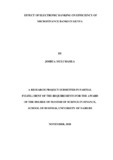| dc.contributor.author | Masila, Joshua M | |
| dc.date.accessioned | 2019-01-18T12:40:27Z | |
| dc.date.available | 2019-01-18T12:40:27Z | |
| dc.date.issued | 2018 | |
| dc.identifier.uri | http://hdl.handle.net/11295/105099 | |
| dc.description.abstract | Electronic banking is important to MFIs as it increases the efficiency of these institutions. Presently, innovation is a continuous process geared toward providing a wider range of financial products and financial intermediation which is a crucial factor in determining competitiveness and the progress of financial institutions. This study sought to determine the effect of electronic banking on efficiency of microfinance banks in Kenya. The study’s population was all the 13 microfinance banks operating in Kenya. Electronic banking in this study was the independent variable with four measures (value of mobile banking transactions per year, value of internet banking transactions per year, value of agency banking transactions per year and value of ATM transactions per year. Efficiency was the dependent variable which the study sought to explain and it was measured by the ratio of total revenue to total assets. Secondary data was collected for a period of 5 years (January 2013 to December 2017) on an annual basis. The study employed a descriptive cross-sectional research design and a multiple linear regression model was used to analyze the association between the variables. Data analysis was undertaken using the Statistical package for social sciences version 21. The results of the study produced R-square value of 0.763 which means that about 76.3 percent of the variation in the Kenyan microfinance banks’ efficiency can be explained by the four selected independent variables while 23.7 percent in the variation of efficiency of microfinance banks was associated with other factors not covered in this research. The study also found that the independent variables had a strong correlation with efficiency (R=0.874). ANOVA results show that the F statistic was significant at 5% level with a p=0.000. Therefore the model was fit to explain the relationship between the selected variables. The results further revealed that mobile banking, agency banking and ATMs produced positive and statistically significant values for this study while internet banking produced positive but non-statistically significant values for this study. This study recommends that measures should be put in place to enhance electronic banking and specifically mobile banking, agency banking and ATMs among microfinance banks as this will improve their efficiency. | en_US |
| dc.language.iso | en | en_US |
| dc.publisher | university of nairobi | en_US |
| dc.rights | Attribution-NonCommercial-NoDerivs 3.0 United States | * |
| dc.rights.uri | http://creativecommons.org/licenses/by-nc-nd/3.0/us/ | * |
| dc.subject | Electronic Banking on Efficiency | en_US |
| dc.title | Effect of Electronic Banking on Efficiency of Microfinance Banks in Kenya | en_US |
| dc.type | Thesis | en_US |



